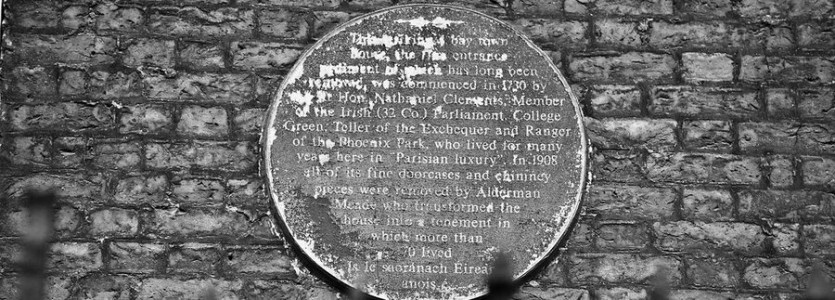The memory of Alderman Joseph Meade
StoriesPublished 14 September 2020

The memory of Alderman Joseph Meade
14 Henrietta Street is delighted to welcome historian Donal Fallon to write a series of blog posts about the building and its rich and varied history.
Today, Donal considers the history of the controversial figure Alderman Joseph Meade
The decline of Henrietta Street - and Dublin more broadly - was a more gradual event in the aftermath of the Act of Union than often presented.
A visitor to 14 Henrietta Street today gets a sense of the period between Georgian townhouse and Victorian tenement, and an understanding that while other parts of Dublin’s inner-city fabric were quickly transformed to tenements, the fortunes of this street were different.
Tenement living comes to Henrietta Street
Only in 1883 did tenement living come to this street, and more specifically to this very house. 14 Henrietta Street was to be the first subdivided tenement home on the street, a status it would maintain until the 1970s.
One name which leaps forth from the pages of Henrietta’s Street tenement history is that of Alderman Joseph M. Meade. He is remembered in the collective memory in a particular way, free of nuance, described in the Evening Herald in 2011 as “the worst of the slum landlords.”
Alderman Meade’s name hides in plain sight not far from 14 Henrietta Street, at the Dublin Fruit and Vegetable Market, his name on its plaque which sits below the city coat of arms, the three burning castles. That building was opened on the 6th December 1892, when Meade was serving as Lord Mayor of Dublin. Historian Bridget Hourican has written of his rise in the city, and how, “he eventually employed 900 men and was contracted for major projects such as the masonry work for the loop line railway, Guinness's printing works, Bray Catholic church, and the beautiful convent of the Sisters of the Poor in South Circular Road. Chairman of numerous boards including the Hibernian Bank and the Globe insurance company, he used his wealth and position to enhance his civic standing.”
Lord Mayor and landlord
Meade was a Home Rule nationalist - and a staunch supporter of Parnell - remaining so even after the so-called Uncrowned King of Ireland’s fall from political grace. Meade was elected Lord Mayor in 1891 and again the following year by his fellow Aldermen, but was not universally popular in the city, condemned in the pages of James Connolly’s The Workers’ Republic for example. When the master painters of the city locked out some 800 employers in a dispute with the painters' union, Meade was condemned by name in Connolly's paper, which insisted "here then is a crucial case for trade unionism."
Meade invested in tenement properties in Dublin - in this he was by no means unique in local politics, as the 1914 Housing Inquiry would reveal numerous Aldermen invested in such housing in the city. When Henrietta Street houses came on the market in the late nineteenth century, Meade acquired a number, with door cases and fireplace features removed from homes and sold at auction, while the physical spaces were subdivided. At the time of Meade’s passing in 1900, his property was valued at some £60,000, the vast majority of it from investment in such homes. Hourican notes that “Nine tenement houses which he owned in Henrietta Street were then auctioned; these alone had provided him with a gross annual rental of £1,500.”
One of many
The popular image of Meade, that of exploitative tenement landlord, perhaps owes more to the century following his death. A plaque erected by Uinseann MacEoin, the architect and historian, having acquired houses on the street noted that, “In 1908 its fine door cases and chimney pieces were removed by Alderman Meade who turned the houses into tenements in which more than 70 lived.” Twentieth century histories of Dublin would pin even later crimes on Meade - discussed as a ‘slumlord’ of the Lockout times, by which time he was longer still dead.
In truth, Meade was far from the most exploitative landlord in the Dublin of his day, obituaries noted his significant philanthropy, while one voice in the 1914 inquiry noted that Meade, "practically reconstructed these houses inside and formed them into flats and provided them generally with sanitary accommodation." The same report revealed that the relationship between local politician and tenement living had only increased, with fourteen Aldermen named. Several owned more than a dozen houses each.
Donal Fallon is a historian, broadcaster and curator from Dublin. Formerly Historian in Residence to Dublin City Council, he is the author of numerous studies of twentieth century Dublin, including The Pillar: The Life and Afterlife of the Nelson Pillar (New Island, 2013). He produces the Three Castles Burning podcast and has contributed to publications including Jacobin, Dublin Historical Review, Saothar and The Irish Times. He is a graduate of Maynooth University, University College Dublin and the Ulster University, and lectures with the Lifelong Learning department of University College Dublin.
 ShopBook Now
ShopBook Now